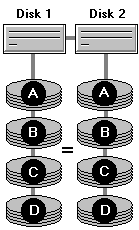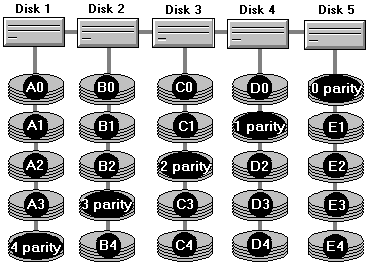RAID Levels and SQL Server
RAID (redundant array of independent disks) levels 0, 1, and 5 are typically implemented with Microsoft® SQL Server™ 2000.
Note RAID levels greater than 10 (1 + 0) offer additional fault tolerance or performance enhancements. These tend to be proprietary systems. For more information about these types of RAID systems, contact the hardware vendor.
Level 0
This level is also known as disk striping because of its use of a disk file system called a stripe set. Data is divided into blocks and spread in a fixed order among all disks in an array. RAID 0 improves read/write performance by spreading operations across multiple disks, so that operations can be performed independently and simultaneously.
RAID 0 is similar to RAID 5, but RAID 5 also provides fault tolerance.

Level 1
This level is also known as disk mirroring because of its use of a disk file system called a mirror set. Disk mirroring provides a redundant, identical copy of a selected disk. All data written to the primary disk is written to the mirror disk. RAID 1 provides fault tolerance and generally improves read performance (but may degrade write performance).

Level 2
This level adds redundancy by using an error correction method that spreads parity across all disks. It also employs a disk-striping strategy that breaks a file into bytes and spreads it across multiple disks. This strategy offers only a marginal improvement in disk utilization and read/write performance over mirroring (RAID 1). RAID 2 is not as efficient as other RAID levels and is not generally used.
Level 3
This level uses the same striping method as RAID 2, but the error correction method requires only one disk for parity data. Use of disk space varies with the number of data disks. RAID 3 provides some read/write performance improvement.
Level 4
This level employs striped data in much larger blocks or segments than RAID 2 or RAID 3. Like RAID 3, the error correction method requires only one disk for parity data. It keeps user data separate from error-correction data. RAID 4 is not as efficient as other RAID levels and is not generally used.
Level 5
Also known as striping with parity, this level is the most popular strategy for new designs. It is similar to RAID 4 in that it stripes the data in large blocks across the disks in an array. It differs in that it writes the parity across all the disks. Data redundancy is provided by the parity information. The data and parity information are arranged on the disk array so that the two are always on different disks. Striping with parity offers better performance than disk mirroring (RAID 1). However, when a stripe member is missing, read performance degrades (for example, when a disk fails).

Level 10 (1+0)
This level is also known as mirroring with striping. This level uses a striped array of disks, which are then mirrored to another identical set of striped disks. For example, a striped array can be created using five disks. The striped array of disks is then mirrored using another set of five striped disks. RAID 10 provides the performance benefits of disk striping with the disk redundancy of mirroring. RAID 10 provides the highest read/write performance of any of the RAID levels at the expense of using twice as many disks.